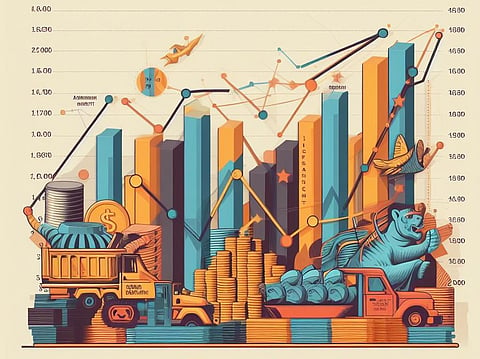

Even as GST collections touch new records, with monthly collections remaining above Rs 1.5 lakh crore consistently, a new working paper from a central government body argues for bringing all goods and services under the tax regime.
At present, the GST regime gives tax exemption to several essential and basic goods and services – such as foodgrains, fruits, vegetables, meat, hospitals, diagnostic tests, education and public transport.
Citing varied evidence, the study argues that imposing GST on such items won't be a burden to taxpayers.
The case made in the working paper rests on two premises: One, it argues that exemptions on goods and services tax are delivering more benefits to households with higher monthly expenditure than the lower strata of consumers.
Two, it found that the exempted items account for only around 20% of a low-income households' monthly expenditure, and hence, bringing them under the tax net is unlikely to pinch consumers' pockets hard.
The working paper, titled 'Distributional Impact of Indian GST', has been brought out by the National Institute of Public Finance and Policy (NIPFP) – an autonomous research institute under the Ministry of Finance. It is the first empirical assessment of the distributional impact of GST.
Until now, there have been no India-specific studies evaluating the distributional impact of the Indian VAT or GST system in Indian public finance literature and hence NIPFP's working paper assumes significance.
Right now, there are 9 tax slabs in GST: (exempted), very low (exempt to 5%), low (5%), lower middle (5-12%), middle (12-18%), upper middle (18%), upper (28%), high (higher than 28%), and lastly out-of-GST.
The study considered 123 major groups of items of households' consumption during 2021-22 to determine the distributional impact of taxes and exemptions. The findings are interesting as they question the premise that the items that are given GST exemption account for a large chunk of the expenditure incurred by poorer sections and therefore benefit them more.
Let’s first look at the lowest income households – or 5% of the households from the bottom when the households are arranged according to personal consumption expenditure. They spent around Rs 934 per person per month in 2021-22 on consumption, according to CMIE’s Consumer Pyramids Household Survey. In contrast, the top 5% spent Rs 5,945 per person per month, according to the same survey.
Now, let’s look at the spending patterns of the lowest income group, or the lowest 5% by income.
According to the analysis made by the working paper, they spent only around 20% of their money on GST-exempt items such as foodgrains, vegetables, fruits, public transport and so on. In contrast, this low-income group spends around 35% of their money on items that are taxed at 5% GST.
Now, let’s compare this to how the richest section of the population, the top 5%, spend their money. The paper found that this section spent a whopping 30% of their expenditure on GST-exempted services such as foodgrains, vegetables, fruits, milk and public transport.
Hence, the study argues that consumers with higher average expenditure – or the richer segments of the population – are getting more of the benefits of GST exemptions, contrary to the common belief that tax exemptions benefit the lower strata of consumers. Hence, the paper suggests that these exempted items, such as foodgrain, milk and public transport, should also be brought under goods and services tax.
It therefore suggests expanding the tax net and reworking the applicability of the slabs.
For instance, look at cereals. Currently, pre-packaged and labelled cereals attract 5% GST, while unpackaged and unlabelled cereals are exempted. Given that average monthly expenditure on cereals increases with increasing size of the consumption basket, it recommended a 5% GST on all cereals, regardless of packaging and labeling. Going by the current expenditure patterns, a uniform 5% rate may not be a tax burden for households.
Likewise, pre-packaging and labeling of salty snacks attract 12% GST, while unpackaged and unlabeled have a 5% levy and suggested removal of differential tax rates.
Apparel under Rs 1,000 attracts 5% GST and those above Rs 1,000 attract 12%. These price-specific rates are prone to revenue leakages if monitoring is not intensive and therefore, removal of price specification and imposing a single GST rate across all such items may increase tax collections. Any attempt to converge two tax rates into one, say 8%, may not significantly increase the prospective tax liability on goods and services.
Similarly, footwear priced under Rs 1,000 has 12% GST, while the rest attract 18%, so merging these into 15% may not have any regressive distributional effect on tax burden. Kitchen appliances and utensils made of iron & steel, aluminum and copper attract GST rate of 12%, while the rest attract 18% and the differential tax structure could lead to revenue leakages and classification disputes. Therefore, a single tax rate on all kitchen appliances and utensils may not only simply GST structure, but also reduce revenue leakages.
Items under high tax rate of 28% and above comprise intoxicants like cigarettes, bidis and others and in addition to the highest GST rate of 28%, they attract GST compensation cess. Consumption of these items accounts for 1-3% of average monthly expenditure, with rural areas having a higher share than in urban areas.